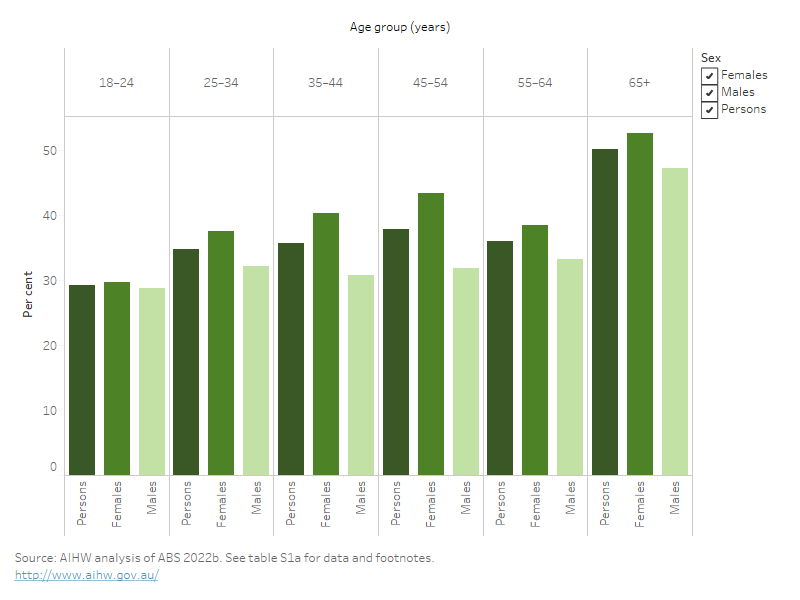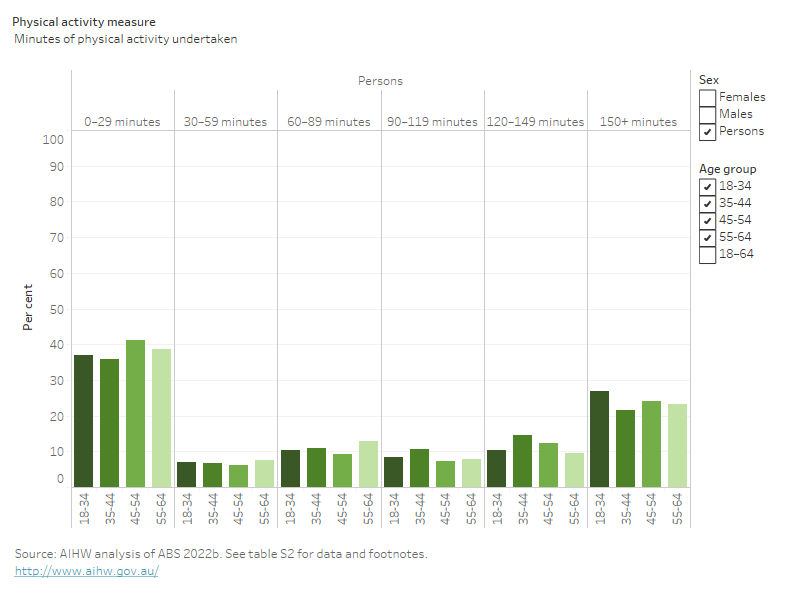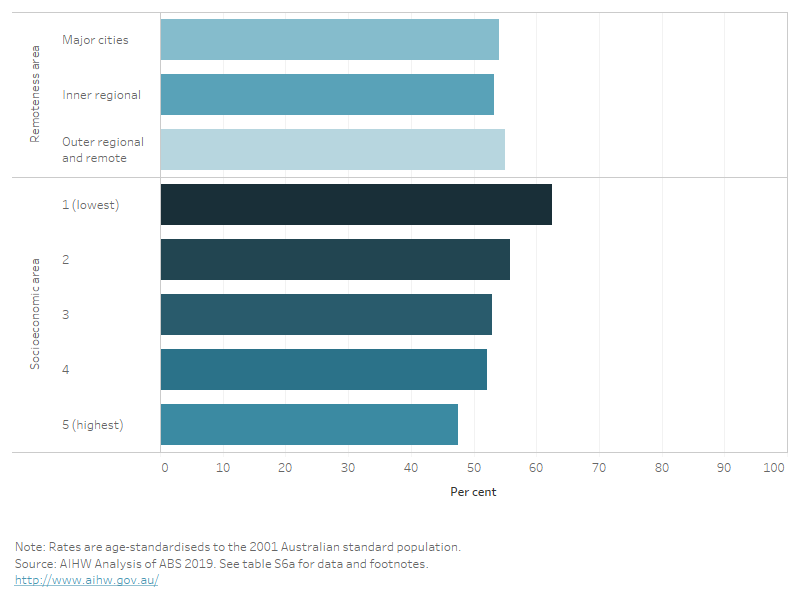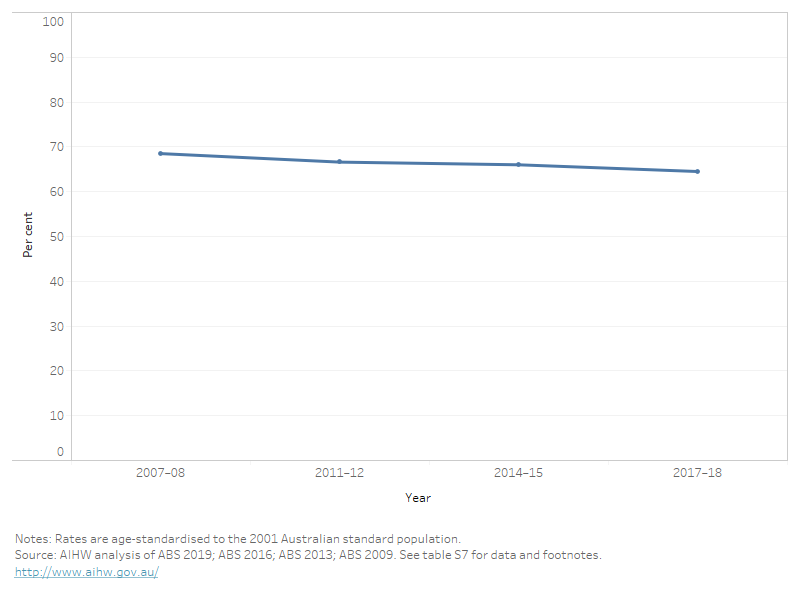Physical activity
Citation
AIHW
Australian Institute of Health and Welfare (2023) Physical activity, AIHW, Australian Government, accessed 25 April 2024.
APA
Australian Institute of Health and Welfare. (2023). Physical activity. Retrieved from https://pp.aihw.gov.au/reports/physical-activity/physical-activity
MLA
Physical activity. Australian Institute of Health and Welfare, 19 May 2023, https://pp.aihw.gov.au/reports/physical-activity/physical-activity
Vancouver
Australian Institute of Health and Welfare. Physical activity [Internet]. Canberra: Australian Institute of Health and Welfare, 2023 [cited 2024 Apr. 25]. Available from: https://pp.aihw.gov.au/reports/physical-activity/physical-activity
Harvard
Australian Institute of Health and Welfare (AIHW) 2023, Physical activity, viewed 25 April 2024, https://pp.aihw.gov.au/reports/physical-activity/physical-activity
Get citations as an Endnote file: Endnote
‘Physical activity’ is any bodily movement produced by skeletal muscles that requires energy expenditure (WHO 2017a). Low levels of physical activity are a major risk factor for chronic conditions. People who are not active enough have a greater risk of developing cardiovascular disease, type 2 diabetes, osteoporosis and dementia. Being physically active improves mental and musculoskeletal health and reduces other risk factors such as overweight and obesity, high blood pressure and high blood cholesterol. Physical activity can also improve symptoms, delay, or halt the progression of a number of conditions, or the onset of associated disease and complications (Pedersen and Saltin 2015).
Some examples of physical activity include:
- sporting and leisure activities, such as swimming, tennis, bushwalking and going to the gym
- incidental activities from being at work, transport to and from work, or household chores
- muscle strengthening activities, such as some types of yoga or Pilates, resistance-band training, high intensity activities (for example, cycling, dancing, gymnastics or gardening that requires digging or lifting), climbing stairs or hills, squats, push-ups, sit-ups, weight training and active playgrounds for children (for example: monkey bars, climbing frames, skipping or hopscotch).
Australia's physical activity and sedentary behaviour guidelines
Being physically active is important across all ages and contributes to health, growth, and development in children and adolescents (WHO 2018). Physical activity and exercise guidelines for all Australians (hereon referred to as the Guidelines) are a set of evidence-based recommendations that outline the minimum amount of physical activity required for health benefits, as well as the maximum amount of time a person should spend on sedentary behaviours to achieve optimal health outcomes.
There are different recommendations for each age group, summarised in the table 1. This approach acknowledges that different amounts of physical activity are required at various stages of life for maximum health benefits (Table 1).
| Ages 1–2 | Ages 3–5a | Ages 5–17b | Ages 18–64 | Ages 65 and over | |
|---|---|---|---|---|---|
Physical activity | At least 180 minutes of energetic play per day. | At least 180 minutes per day with at least 60 minutes of energetic play. | At least 60 minutes of moderate to vigorous activity involving mainly aerobic activities per day. | Be active on most, preferably all days with at least 150 minutes of moderate to vigorous activity per week. | Be active on most, preferably all days with at least 30 minutes of moderate activity per day. |
Strength | N/A | N/A | At least 3 days a week | Muscle strengthening activities 2 times a week | Incorporate muscle strengthening activities |
Sedentary or screen-based activityc | Do not restrain for more than 1 hour at a time. Under 2 years should have no sedentary screen time. For 2 years, no more than 60 minutes of sedentary screen time per day. | Should not be restrained for more than 60 minutes at a timed. | No more than 120 minutes of screen use. | Minimise and break up prolonged periods of sitting. | Be as active as possible. |
Notes:
- This group includes those aged 5 who are not yet in full-time schooling (for example, pre-schoolers).
- This group includes those aged 5 who are in full-time schooling.
- Does not include screen time needed for school-work.
- Examples include being restrained in a stroller, car seat or high-chair.
Do Australians meet the physical activity guidelines?
The following section presents data on whether or not Australians meet the Guidelines by the following age groups:
- children aged 2–14
- young people aged 15–17
- adults aged 18–64
- adults aged 65 and over.
The interactive graphs can also be used to explore how much physical and muscle strengthening activity is being done by young people aged 15–17 and adults aged 18 and over, who do not meet the recommended amount of physical activity.
Children aged 2–14
The most recent detailed data available on physical activity and sedentary screen time for children and young people aged 2–14 is from the Australian Bureau of Statistics (ABS) 2011–12 National Nutrition and Physical Activity Survey (NNPAS). The NNAPS is scheduled to be conducted again in 2023 as part of the Intergenerational Health and Mental Health Study.
The majority of children aged 2–14 did not meet the Guidelines (AIHW 2018):
- Over 8 in 10 (83%) of children aged 2–5 did not meet both the physical activity component and the screen-based activity component – 39% did not meet the physical activity component and 75% did not meet the screen-based activity component.
- Nearly 9 in 10 (88%) children aged 5–12 did not meet both the physical activity component and the screen-based activity component – 74% did not meet the physical activity component and 65% did not meet the screen-based activity component.
- Over 9 in 10 (96%) young people aged 13–14 did not meet both the physical activity component and the screen-based activity component – 89% did not meet the physical activity component and 77% did not meet the screen-based activity components.
For more information on children’s physical activity, see Physical activity across the life stages.
Data considerations
The next sections use the latest self-reported data from the ABS’s 2020–21 National Health Survey (NHS). The survey relies on people accurately remembering their physical activity levels in the previous week. This can introduce recall bias and lead to over or underestimations of the amount of physical activity completed.
The 2020–21 NHS was conducted during the COVID-19 pandemic, which significantly changed the data collection method, from face-to-face interviews to online, self-completed forms. This impacted response rates and the sample representativeness for some sub-populations. Additionally, the pandemic and lockdowns might also have had direct or indirect impacts on people’s behaviours over the 2020–21 period. The module used to collect physical activity information was changed as part of the 2020–21 NHS.
The 2020–21 NHS should be considered a break in series from previous NHS collections and used for point-in-time analysis only. The data should not be compared to previous NHS data on physical activity participation.
For more information, refer to the Technical notes.
Insufficient physical activity definitions
‘Insufficient physical activity’ is defined here as:
- for young people aged 15–17: not completing 60 minutes per day of physical activity on each day of the previous week
- for adults aged 18–64: not completing 150 minutes of moderate to vigorous activity (where time spent on vigorous activity is multiplied by 2) across 5 or more days a week
- for adults aged 65 and over: not completing 30 minutes or more of physical activity on at least 5 days each week.
However, it should be noted that doing some, or even a small amount, of physical activity is better than none, due to the positive benefits associated with physical activity and the reduction in the risk of disease burden (AIHW 2017, WHO 2020).
Young people aged 15–17
Based on the latest available data, it is estimated that over 7 in 10 (73%) young people aged 15–17 are insufficiently physically active. A large proportion (78%) also did not do the recommended 3 days a week of muscle strengthening activity (ABS 2022b).
Based on the latest available data, among those who are insufficiently physical active (ABS 2022b):
- 32% did some physical activity on all 7 days but did not meet the recommended 60 minutes of physical activity per day
- 13% were completely physically inactive (that is, did 0 days of physical activity in the last week).
For those who did not meet the muscle strengthening activity guideline, 13% did strength activities on 2 days in the last week. The majority (74%) did not do any strength activities on any day in the last week.
Adults aged 18–64
Based on the latest available data, it is estimated that 75% of adults aged 18–64 did not meet both the physical activity component and the muscle-strengthening component of the Guidelines. This proportion was higher in women (78%) than men (73%) (ABS 2022b).
Physical activity
Based on the latest available data, over 3 in 10 (35%) adults aged 18–64 are insufficiently physically active. More women (39%) than men (32%) did not do the recommended amount of physical activity (ABS 2022b).
The proportion of people who are insufficiently physically active generally increases with increasing age (Figure 1). Among 18–24-year-olds, 29% of men and 30% of women are insufficiently active. This increased to 47% of men and 53% of women aged 65 and over.
Figure 1: Proportion of insufficiently active adults aged 18–64, by age and sex, 2020–21
This bar chart shows the differences for males, females and all persons for insufficient physical activity. Generally, insufficient physical activity increases with age, and this is more pronounced in females compared to males, with those aged 65 and over having the least amount of physical activity.

Based on the latest available data, among adults aged 18–64 who are insufficiently physically active:
- 14% did some amount of physical activity on 5 or more days in the last week but did not do the recommended 150 minutes of physical activity per week – this was similar for both men (14%) and women (13%)
- 35% were completely physically inactive (that is, did 0 days of physical activity in the last week) – this was similar for both men (36%) and women (35%)
- 24% did 150 minutes or more of physical activity but did not do so on at least the recommended number of days – this was similar for both men (25%) and women (23%)
- almost 4 in 10 (38%) did less than 30 minutes of physical activity in the last week – this was similar for both men (39%) and women (37%) (Figure 2).
Figure 2: Participation in physical activity by days and minutes among adults aged 18–64 who were insufficiently physically active, 2020–21
By selecting the different physical activity measure, this bar chart will show the amount of activity undertaken in minutes per week, or days per week for differing age groups. Generally, most people do little to no physical activity, however about 25% of people complete the recommended 150 minutes of exercise, and this is mostly completed over 3 or 4 days.

Muscle strengthening activity
Based on the latest available data, over 7 in 10 (72%) adults aged 18–64 did not do the recommended 2 days a week of muscle strengthening activity. This proportion is higher in women (74%) than men (70%).
Among those who did not meet the muscle strengthening guideline (at least 2 days of muscle strengthening activities per week), fewer than 11% of men or women, across all age sub-groups, except for women aged 18–34 (14%), did muscle strengthening activities on 1 day in the last week. The proportion of people who did muscle strengthening activity on 1 day in the last week generally decreased as age increased (ABS 2022b).
Adults aged 65 and over
Based on the latest available data, it is estimated that nearly 9 in 10 (87%) adults aged 65 and over did not meet the physical activity component and the muscle-strengthening component of the Guidelines. The difference in proportions of men (88%) and women (85%) aged 65 and over who did not meet both components is not statistically significant.
Physical activity
Based on the latest available data, half (50%) of adults aged 65 and over are insufficiently physically active. The difference in the proportions of men (47%) and women (53%) is not statistically significant (Figure 1).
Among those who are insufficiently physically active:
- 25% did some amount of physical activity on 5 or more days in the last week but did not do the recommended number of minutes of physical activity – more men (29%) than women (22%) did some activity on 5 or more days
- 35% were completely physically inactive (that is, did 0 days of physical activity in the last week)
- 26% did 150 minutes or more of physical activity but did not do so on at least the recommended number of days – this was similar for both men (28%) and women (25%)
- almost 4 in 10 (37%) did less than 30 minutes of physical activity (Figure 3).
Figure 3: Participation in physical activity by days and minutes among adults aged 65 and over who did not meet the physical activity guidelines, 2020–21
By selecting the different physical activity measure, this bar chart will show the amount of activity undertaken in minutes per week, or days per week for people aged over 65 years. Generally, most people in this age group do little to no physical activity, however about 25% of people complete the recommended 150 minutes of exercise, and this is mostly completed over 5 days, and this is more evident for males.

Muscle strengthening activity
Based on the latest available data, over 8 in 10 (81%) of adults aged 65 and over did not do at least 2 days of muscle strengthening activity. This is similar for men (80%) and women (81%).
Among those who did not do at least 2 days of muscle strengthening activity, the majority (94%) did no strength activities at all (that is, did 0 days of activity). A small proportion (5.8%) did muscle strengthening activities on 1 day of the week (ABS 2022b).
How does physical activity vary across population groups?
Based on the latest available data, the proportions of adults aged 18 and over who are insufficiently physically active is similar across remoteness areas, in 2017–18 (ABS 2019):
- 55% for Outer regional and remote areas
- 53% for Inner regional areas
- 54% for Major cities.
Over 6 in 10 (63%) people from the lowest socioeconomic areas are insufficiently physically active, compared with 48% in the highest socioeconomic areas (Figure 4) (ABS 2019).
Figure 4: Prevalence of insufficient physical activity among adults aged 18 and over, by selected population characteristics, 2017–18
This bar chart shows that insufficient physical activity is generally the same across regional areas but is greater for those in lower socioeconomic areas.

Has physical activity participation changed across time?
Based on the latest available data, after adjusting for age, there is a slight decrease in the proportion of adults aged 18 and over who are insufficiently physically active between 2007–08 and 2017–18, decreasing from 69% to 65%. However, rates have not changed significantly since 2011–12 (Figure 5) (ABS 2009, ABS 2013, ABS 2016, ABS 2019).
Figure 5: Proportion of adults who did not meet the physical activity component of the guidelines, 2007–08 to 2017–18
This line graph shows that the trend for not meeting the physical activity guidelines has changed little over the 10 years since 2007-08, decreasing by 4%.

What are the health impacts of physical inactivity?
Burden of disease is a measure of the years of healthy life lost from living with ill health or dying prematurely from disease and injury. This includes how much risk factors contribute to this burden.
Physical inactivity is the 9th leading preventable cause of ill health and premature death, responsible for 2.5% of total disease burden in Australia, in 2018.
Physical inactivity increases the risk of many diseases and is causally linked to the burden from type 2 diabetes, bowel cancer, dementia, coronary heart disease and strokes, as well as uterine and breast cancer in females.
Physical inactivity contributes to (AIHW 2021):
- 20% of type 2 diabetes total disease burden
- 16% of coronary heart disease burden
- 16% of the uterine cancer burden
- 12% of bowel cancer burden
- 12% of dementia burden
- 9.2% of stroke burden
- 3.2% of breast cancer burden.
Physical inactivity also contributes to 8,253 deaths (5.2% of total deaths) (AIHW 2021).
For more information on the disease burden due to physical inactivity, see Burden of disease.
How did COVID-19 impact physical activity?
The relationship between public health measures designed to address COVID-19 and physical activity is complex.
Restrictions on some activities and gathering sizes commenced in March 2020 in Australia. During early April to early May 2020, data from the 2020 ABS Household Impacts of COVID-19 Survey showed more Australians aged 18 and over reported increasing (25%) than decreasing (20%) their time spent on exercise or other physical activity than they did prior to the restrictions (in March 2020). In late June 2020, a similar proportion of people reported increasing (21%) or decreasing (19%) their time spent on exercise or other physical activity.
Data also suggests that the type of physical activities that adults participated in changed between April to June 2020. Participation in recreational and fitness activities (for example, home exercise, bike riding and recreational walking) were least impacted by COVID-19 restrictions, while participation in organised and team sports (for example, football/soccer, basketball and gym workouts) decreased over this period.
In June 2020, as a national three step plan to ease COVID-19 restrictions was implemented, there were a small proportion of people who reported going to a gym, boot camp or swimming pool (5.5%) and playing sports or attending training sessions (12%). In August 2020, those who went to a gym, boot camp or swimming pool increased to 16% and those who played sports or attended a training session had increased to 18% (ABS 2020c).
As Australians adapt to the ‘COVID-normal’, data are starting to show evidence that the participation habit of Australians are changing as well as their motivation for exercising, with an increase in people being motivated by mental health benefits. Compared to pre-pandemic, fewer Australians are relying solely on sporting clubs or organised venues for exercise. Activities such as walking (recreational) and bushwalking have increased in participation in both 2020 and 2021 (AusPlay 2022).
Two years on from the initial restrictions, fewer Australian adults reported exercising at a gym or playing an organised sport one or more times per week (25% in June 2021) than they did prior to the restrictions in March 2020 (38%) (ABS 2021). Although by February 2022, this rose to 30% (ABS 2022a).
For more information on how the pandemic has affected the population's health in the context of longer-term trends, see ‘Chapter 2 Changes in the health of Australians during the COVID-19 period’ in Australia’s health 2022: data insights.
Where do I go for more information?
- The relationship between health risk factors and the neighbourhood environment
- Physical activity across the life stages
- Australian Burden of Disease Study 2018: Interactive data on risk factor burden
- Muscle strengthening activities among Australian adults
- Physical activity during pregnancy 2011–12
Visit Physical activity for more on this topic.
Technical notes
About the Australian Bureau of Statistics National Health Surveys
This web report uses data from the following surveys from the Australian Bureau of Statistics (ABS):
- 2020–21 National Health Survey (NHS)
- 2017–18 NHS
- 2011–12 National Nutrition and Physical Activity Survey (NNPAS).
The National Health Survey is a series of surveys designed to collect a range of information about the health of Australians, including:
- prevalence of long-term health conditions
- health risk factors such as smoking, fruit and vegetable consumption, alcohol consumption and exercise
- use of health services such as consultations with health practitioners and actions people have recently taken for their health
- demographic and socioeconomic characteristics.
The most recent 2020–21 NHS was conducted from August 2020 to June 2021. As it was conducted during the COVID-19 pandemic, to ensure the safety of interviewers and respondents, the survey was collected via online, self-completed forms (previous iterations of the NHS was conducted via face-to-face interviews).
Non-response is usually reduced through interviewer follow-up of households who have not responded. As this was not possible during lockdown periods, there were lower response rates than previous NHS cycles, which impacted sample representativeness for some sub-populations.
Additionally, the impact of COVID-19 and lockdowns might also have had direct or indirect impacts on people’s usual behaviour over the 2020–21 period, and the module used to collect information on physical activity was changed as part of the NHS 2020–21. Due to these impacts and changes, the 2020–21 NHS is considered a break in series and should only be used for point-in-time national analysis only.
For this reason, the 2020–21 NHS is used to report physical activity data at national level only. Data on physical activity variation by population groups uses the 2017–18 NHS; and data on trends in physical activity across time are presented from 2007–08 to 2017–18.
For more information, please refer to the ABS National Health Survey: First results methodology.
ABS (Australian Bureau of Statistics) (2009) Microdata: Australian Health Survey, National Health Survey, 2011–12, Findings based on Expanded Confidentialised Unit Record File analysis, abs.gov.au, accessed 28 March 2023.
ABS (2013) Microdata: Australian Health Survey, National Health Survey, 2011–12, Findings based on Expanded Confidentialised Unit Record File analysis, abs.gov.au, accessed 28 March 2023.
ABS (2016) Microdata: National Health Survey, 2014–15, Findings based on Expanded Confidentialised Unit Record File analysis, abs.gov.au, accessed 28 March 2023.
ABS (2019) Microdata: National Health Survey, 2017–18, Findings based on Detailed Microdata analysis, abs.gov.au, accessed 28 March 2023.
ABS (2020a) Household Impacts of COVID-19 Survey, 24–29 June 2020, abs.gov.au, accessed 28 March 2023.
ABS (2020b) Household Impacts of COVID-19 Survey, 29 Apr–4 May 2020, abs.gov.au, accessed 4 October 2022.
ABS (2020c) Household Impacts of COVID-19 Survey, August 2020, [Table 9.1: Activities done in the last week as COVID-19 restrictions ease by sex and age], abs.gov.au, accessed 28 March 2023.
ABS (2020d) Household Impacts of COVID-19 Survey, June 10-15 2020, [Table 7.1: Activities as COVID-19 restrictions ease by sex and age], abs.gov.au, accessed 28 March 2023.
ABS (2021) Household Impacts of COVID-19 Survey, June 2021, [Table 26.1: Frequency of activities, by sex and age, Time series], abs.gov.au, accessed 28 March 2023.
ABS (2022a) Household Impacts of COVID-19 Survey, February 2022, [Table 4.1: Frequency of activities, by sex and age, Time series], abs.gov.au, accessed 28 March 2023.
ABS (2022b) Microdata: National Health Survey, 2020–21, AIHW analysis of microdata, abs.gov.au, accessed 28 March 2023.
AIHW (Australian Institute of Health and Welfare) (2017) Impact of physical inactivity as a risk factor for chronic conditions: Australian Burden of Disease, aihw.gov.au, accessed 28 March 2023.
AIHW (2018) Physical activity across the life stages, aihw.gov.au, accessed 21 September 2022.
AIHW (2021) Australian Burden of Disease Study 2018: Interactive data on risk factor burden, AIHW website, accessed 17 October 2022.
AusPlay (2021) Ongoing impact of COVID-19 on sport and physical activity participation June 2021 update, www.clearinghouseforsport.gov.au/research/ausplay, accessed 28 March 2023.
AusPlay (2022) How Australians’ participation in sport and physical activity is adapting to COVID-normal – July 2022 update, www.clearinghouseforsport.gov.au, accessed 28 March 2023.
DoHAC (Department of Health and Aged Care) (2021) Physical activity and exercise guidelines for all Australians, health.gov.au, accessed 18 February 2023.
Pedersen B and Saltin B (2015) Exercise as medicine – evidence for prescribing exercise as therapy in 26 different chronic diseases, Scandinavian Journal of Medicine and Science in Sports, 25:1-72, https://doi.org/10.1111/sms.12581.
WHO (World Health Organisation) (2018) Global action plan on physical activity 2018–2030: more active people for a healthier world, www.who.int/news-room/initiatives/gappa, accessed 21 September 2022.
WHO (2020) WHO guidelines on physical activity and sedentary behaviour: at a glance, www.who.int, accessed 28 March 2023.


